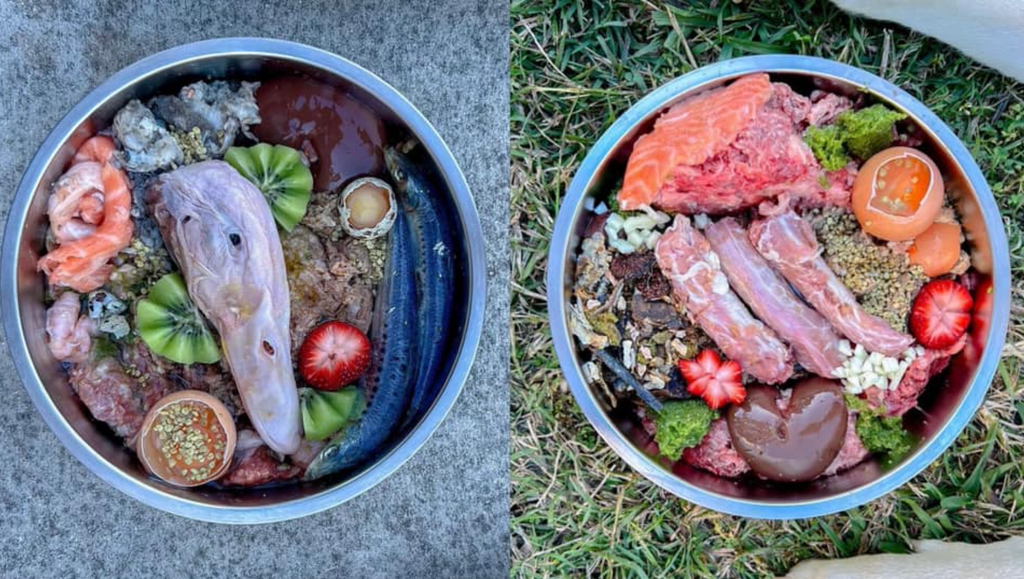
Is raw meat best for dogs
We all want our pets to have the best dog food.
And over the past few years, the raw meat diet for dogs has become popular.
But is raw meat really the best choice for dogs?
Today, we'll talk about whether raw meat dog food is good for dogs. This includes how it affects digestion, skin conditions, managing weight, and general health. By the end, you'll know if a raw meat diet suits your dog.

Key Takeaways:
- A raw meat diet has gained popularity among dog owners seeking to provide their pets with a fresh, whole food diet.
- A raw meat diet can improve digestion, skin conditions, weight management, and overall wellbeing..
- Consulting with a canine nutritionist or following AAFCO recipes is crucial in ensuring your dog's nutritional needs are met
The Benefits of a Fresh, Whole Food Diet for Dogs
A fresh, whole dog food diet can make dogs healthier and happier. It includes raw dog food, recipes for homemade meals, and treats, all of which are easy to make. By choosing these options, pet owners can ensure their dogs get meals that are both tasty and good for them.
Improved Digestion
Feeding dogs fresh, whole foods can make a big difference in their digestion. Unlike many commercial foods, homemade meals are made from simple, natural ingredients. This leads to less tummy trouble and better use of nutrients by the body. So, your dog feels better and gets more from their food.
Enhanced Skin Conditions
A good diet can really show on a dog's skin and coat. Fresh, whole food recipes are rich in nutrients like omega-3, vitamins, and minerals. These help nourish the skin, reduce scratching, calm allergies, and make the coat shine. Your dog will look and feel amazing.
Weight Management
Homemade meals are great for controlling your dog's weight. It's perfect for those needing to slim down. By picking the right dog food recipes, you can make sure they eat well, stay healthy, and manage their weight.
Overall Wellbeing
A fresh, whole dog food diet gives dogs the nutrients they need to thrive. These meals are full of proteins, good fats, and vitamins. They boost the immune system, energy, and keep the body running well. Your dog will be healthy, and full of life.
"A fresh, whole food diet can offer a range of benefits for dogs, including improved digestion, enhanced skin conditions, better weight management, and overall wellbeing. By incorporating homemade dog food recipes into their pet's diet, owners can provide nutritious meals that are vet-approved and can be easily prepared at home."
Understanding the Raw Food Dog Diet
The raw food dog diet is becoming more and more popular. It focuses on giving dogs fresh, unprocessed foods. This means raw meat, bones, fruits, and vegetables, just as they would find in the wild.
Its goal is to mimic what dogs' ancestors ate. Raw dog food matches a dog's natural needs since dogs are meat-eaters. By giving dogs raw meat, bones, and organs, it's thought to improve digestion and strengthen their immune system.
But it's not just meat. This diet also includes raw fruits and veggies. These add important vitamins, minerals, and fibre to a dog's diet. For example, you might see apples, carrots, or broccoli in a dog's raw dog food meal.
However, the raw food diet for dogs needs careful thought. It could miss out on some nutrients essential for dogs, such as calcium and vitamin D. To make sure dogs get all they need, some owners add supplements. Or they ask a vet or nutrition expert for advice.
Or you can follow Healthy Active Pet recipes that are balanced and meet AAFCO minimum standards.

Benefits of the Raw Food Dog Diet:
- Promotes better digestion
- Enhances muscle development
- Boosts the immune system
- Provides essential vitamins and minerals
- Offers a more natural and species-appropriate diet
| Raw Food Dog Diet | Commercial Dog Food |
|---|---|
| Focuses on fresh, unprocessed ingredients | May contain preservatives and additives |
| May improve overall digestion | Digestive issues may arise |
| Provides essential nutrients in their natural form | Nutrient content may vary |
| Promotes a natural and species-appropriate diet | May contain fillers and unnecessary ingredients |
Transitioning to a Raw Meat Diet
Switching your dog to a raw meat diet needs careful thought and close watching. Aim for a smooth move and make sure your dog stays healthy. If your dog isn’t used to raw food, or you're switching their current diet, these steps are your guide.
1. Gradual Transition
Start by swapping some of your dog's current food with raw. Introduce small amounts of raw meat. Then, slowly add more over a few weeks. This step-by-step change helps your dog's tummy get used to the new diet. It also cuts the chance of any tummy troubles.
2. Monitor Your Dog's Response
Watch how your dog reacts closely. Look out for changes in their energy, fur, and the state of their poos. It's normal for dogs to need time to adjust to new food. But, if you're worried about any ongoing problems, get advice from your vet.
3. Adjusting the Diet
Tweak the raw meat meals if necessary. Not all dogs need the same food. Keep an eye on your dog's weight, fitness, and health to make sure they get all the right nutrients. If needed, your vet or a pet nutritionist can help with custom diet advice.
4. Vet-Approved Homemade Dog Food Recipes
Homemade dog food can be used during the transition. It is a good and safe way to make sure your dog eats well while they're getting used to raw food.
You can follow Healthy Active Pet recipes that are balanced and meet AAFCO minimum standards.

Transitioning to a Raw Meat Diet - Checklist:
- Gradually replace a portion of your dog's current diet with raw food.
- Observe your dog's response to the new diet closely.
- Make adjustments to the raw meat diet as needed.
- Incorporate vet-approved homemade dog food recipes during the transition period.
Frequently Asked Questions
More dog owners are looking into a raw food diet for their pets. They have lots of questions and worries. Here's some common questions answered to help you understand raw meat diets for dogs.
1. Is it safe to feed my dog raw meat?
Always use fresh, high-quality meat and keep it well refrigerated to avoid bacteria.
2. What are the nutrient requirements for dogs on a raw food diet?
Dogs need the right mix of protein, fats, carbs, vitamins, and minerals on a raw food diet. Approved homemade recipes can make sure your dog gets everything they need. Follow Healthy Active Pet recipes that are balanced and meet AAFCO minimum standards.
3. How do I determine the portion sizes for a raw meat diet?
For raw meat diets, portion sizes vary based on your dog's size, age, and energy levels. Follow Healthy Active Pet recipes that are balanced and meet AAFCO minimum standards.
4. Can I feed my dog raw bones?
Raw bones can be good for your dog's teeth and provide calcium. But, choose bones that are safe for chewing and always watch your dog when they eat them to prevent accidents..
5. Can I prepare homemade dog food recipes at home?
Yes, making homemade dog food is a popular choice for many pet owners. It lets you pick the ingredients and be sure they're safe. Just follow trustworthy recipes and advice.
Follow Healthy Active Pet recipes that are balanced and meet AAFCO minimum standards.
| Question | Answer |
|---|---|
| Is it safe to feed my dog raw meat? | Feeding dogs raw meat can be safe if you follow proper food handling practices. |
| What are the nutrient requirements for dogs on a raw food diet? | Dogs on a raw food diet need a balanced intake of proteins, fats, carbohydrates, vitamins, and minerals. |
| How do I determine the portion sizes for a raw meat diet? | The portion sizes for a raw meat diet depend on your dog's weight, age, activity level, and individual needs. |
| Are there alternatives to raw feeding? | If a raw meat diet is not suitable for your dog, there are alternative options available. |
| Can I mix kibble with a raw food diet? | Yes you can and this is often called hybrid feeding |
| What if my dog has specific dietary needs or health conditions? | If your dog has specific dietary needs or health conditions, it is crucial to consult with a veterinarian or canine nutritionist. |
| Can I feed my dog raw bones? | Feeding dogs raw bones can provide dental benefits and a natural source of calcium. |
| Can I prepare homemade dog food recipes at home? | Absolutely! Many dog owners prefer to prepare homemade dog food recipes because it gives them control over the ingredients. Follow Healthy Active Pet recipes that are balanced and meet AAFCO minimum standards. |
Monitoring Your Dog's Health on a Raw Meat Diet
Feeding your dog raw meat has many benefits. But, it's vital to watch their health closely. Make sure to take them for check-ups. It's also good to keep an eye on any changes you notice.
Switching to raw meat can have positive effects. Yet, it's very important to check how your dog is doing. Look out for changes in their fur, weight, energy, and how their stool looks. This will help you see if they are doing well or if something is wrong.
Keeping a close watch on your dog's fur is important too. A shiny coat usually means they are healthy. If their fur doesn't look good, it might be a sign of health problems.
What about their weight and how active they are? These are big clues to their health. Make sure they stay at a good weight and have lots of pep. Too much or too little weight, or if they're really tired, are signs to watch out for.
"Regular trips to the vet are crucial for your dog on a raw meat diet," says Dr. Amanda Smith. She knows a lot about what dogs need to eat well.
Don't forget about their poop! It can show if there are tummy problems. Healthy dogs will have solid, easy-to-pass poops. If there are changes in how their poop looks, it might mean they're not well.
By staying alert to these health signs, you make sure your dog benefits from the raw meat diet. Their well-being is our ultimate goal.
| Aspects to monitor on a raw meat diet: | Indicators of good health: | Indicators of potential issues: |
|---|---|---|
| Coat Condition | Shiny and lustrous coat | Dull or dry coat |
| Weight | Maintaining a healthy weight | Significant weight loss or gain |
| Energy Levels | Consistent and sustained energy | Excessive fatigue or lethargy |
| Stool Quality | Firm, well-formed, and easy to pass stool | Changes in consistency, color, or frequency |




